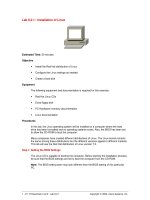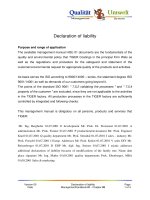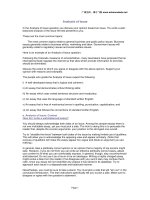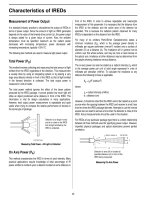Tài liệu Effect of a school-based oral health education programme in Wuhan City, Peoples Republic of China ppt
Bạn đang xem bản rút gọn của tài liệu. Xem và tải ngay bản đầy đủ của tài liệu tại đây (566.63 KB, 9 trang )
International Dental Journal (2004) 54, 33–41
© 2004 FDI/World Dental Press
0020-6539/04/01033-09
Effect of a school-based oral health
education programme in Wuhan
City, Peoples Republic of China
Poul Erik Petersen
Geneva, Switzerland
Bin Peng, Baojun Tai, Zhuan Bian
and Mingwen Fan
Wuhan, China
Objectives: To assess oral health outcomes of a school-based oral
health education (OHE) programme on children, mothers and schoolteach-
ers in China, and to evaluate the methods applied and materials used.
Design: The WHO Health Promoting Schools Project applied to primary
schoolchildren in 3 experimental and 3 control schools in Hongshan
District, Wuhan City, Central China, with a 3-year follow-up. Data on dental
caries, gingival bleeding and behaviour were collected. Participants: 803
children and their mothers, and 369 teachers were included at baseline in
1998. After three years, 666 children and their mothers (response rate
83%), and 347 teachers (response rate 94%) remained. Results: DMFT/
DMFS increments were comparable but the f/F components were higher
among children in experimental schools than in control schools and
the gingival bleeding score was, similarly, significantly lower. More children
in experimental schools adopted regular oral health behaviour such as
toothbrushing, recent dental visits, use of fluoride toothpaste, with less
frequent consumption of cakes/biscuits compared to controls. In experi-
mental schools, mothers showed significant beneficial oral health
developments, while teachers showed higher oral health knowledge and
more positive attitudes, also being satisfied with training workshops,
methods applied, materials used and involvement with children in OHE.
Conclusions: The programme had positive effects on gingival bleeding
score and oral health behaviour of children, and on oral health knowledge
and attitudes of mothers and teachers. No positive effect on dental caries
incidence rate was demonstrated by the OHE programme.
Key words: Oral health education, caries, gingival bleeding, oral health
behaviour, China
At the global level, prevalence rates
and patterns of oral disease have
changed considerably over the past
two decades. In most industrial-
ised countries, the prevalence
proportion rates of dental caries
and the mean dental caries experi-
ence in children have declined
14
.
Such changes are often ascribed to
changing living conditions and life-
styles, effective use of oral health
services, implementation of school-
based oral health care programmes,
adoption of regular self-care
practices and use of fluoride tooth-
paste
57
. Against this, increasing
levels of dental caries among
children are observed in some
developing countries, especially
for those countries where commu-
nity-based preventive oral care
programmes are not established
1
.
In order to control the growing
burden of oral diseases, a number
of developing countries recently
introduced school-based oral health
education (OHE) and preventive
programmes which aim at improv-
ing oral health behaviour and status
of the child population. The initial
evaluations from such health
projects conducted in Indonesia
8
,
Brazil
9
and Madagascar
10
have
disclosed some encouraging results.
In China, the prevalence of dental
caries of children at age 5 years
was recently reported at 76.6% and
Correspondence to: Dr. Poul Erik Petersen, World Health Organisation, 20 Avenue Appia,
CH-1221 Geneva 27, Switzerland. E-mail:
34
International Dental Journal (2004) Vol. 54/No.1
Figure 1.
Map of study area: Hubei Province
the mean DMFT of 12-year-olds
was 1.0
11
. It is noteworthy that the
d/D-component constitutes most
of the caries index. Moreover,
gingival health status and oral health
habits of children seem poor
1113
.
The Chinese health authorities have
emphasised preventive oral care
and oral health education since the
late 1980s. The nationwide mass
campaign Love Teeth Day has
been conducted annually since 1989
to support the implementation of
community-based oral health educa-
tion, with positive changes found
at the population level
14,15
. Oral
health education in relation to
schoolchildren is given high priority.
In a previous survey, the Chinese
schoolteachers showed higher
dental knowledge and more posi-
tive attitudes towards prevention
as compared with the parents
13
. Also,
they expressed interest in becoming
involved in oral health education
of children. However, systematic
school-based OHE programmes
have not yet been established at the
national level in China. In 1998, the
Hubei Province Committee for Oral
Health, with the assistance of the
World Health Organisation (WHO)
Collaborating Centre for Commu-
nity Oral Health Programmes and
Research, University of Copenha-
gen, implemented demonstration
projects in primary schools in
Wuhan City, PR China. The purpose
of the present study is to assess the
outcome of the OHE programme
on children, mothers and school-
teachers over a period of three
years. The outcome is measured in
terms of effect on dental caries
experience and oral health habits
of children, and oral health knowl-
edge, attitudes and behaviour of
mothers. In addition, levels of oral
health knowledge and attitudes of
teachers and their involvement in
oral health education were meas-
ured for process evaluation.
Study population and methods
Setting
This evaluation study is based on a
demonstration project carried out
in the Hongshan District of Wuhan
City, Hubei Province, which is
located in central China (Figure 1).
The fluoride concentration of
drinking water in the district is low
(0.2ppm). Dental care is mainly
offered on demand from one
dental hospital with about 100
dental units and no organised
school-based OHE programmes
were established in the district. In
1998, six representative primary
schools were chosen at random
from this district; three were termed
experimental schools and three
control schools.
The OHE programme
All children in grade 1 attending
experimental schools took part
in a 3-year school-based OHE
programme, based on the concept
of the WHO Health Promoting
Schools Project aimed at healthy
environment and involvement of
schoolteachers in classroom activi-
ties. These activities focussed on
integrating oral health education
35
Petersen
et al
.: School -based oral health education programme in Wuhan City
day with use of fluoride toothpaste
was recommended. Moreover, the
mothers were encouraged to be
present during oral hygiene instruc-
tions and were informed about
methods of cleaning and how to
take responsibility for their childs
teeth on a daily basis. In addition,
the schools received various
macromodels, slides, posters and
other didactic materials to support
the OHE activities. Monthly OHE
sessions were part of the curriculum
and instructions were performed
on average 30 times over the 3-
year evaluation period. Through-
out the project activities in schools
were supervised by public health
dentists.
Participants
In 1998, a total of 918 children were
clinically examined and 803 moth-
ers (87% of the original sample)
completed self-administered ques-
tionnaires. Only children who were
examined and whose mothers
completed the questionnaires were
included in the baseline data, with
404 children (86% of the original
sample) in the experimental and
399 (89% of the original sample) in
the control group. In addition, 33
teachers responsible for children in
the experimental schools were
included and 336 teachers from
other schools of the district served
as the reference group. In all, 88%
of teachers chosen responded to
the questionnaires.
At the follow-up examination
in 2001, 335 children and 331
children remained in the experi-
mental and control groups,
respectively. The drop-out rate was
17%; most being caused by
transfer of children to other schools
or their mothers being absent
when the questionnaires were to be
completed. At follow-up, there
were 32 teachers (drop-out rate
3%) and 315 teachers (drop-out
rate 6%) who remained in the
experimental and control schools,
respectively.
Collection of data
The baseline oral examination was
carried out in September 1998 and
the follow-up examination took
place in October 2001. Children
from the six primary schools
participated in a clinical examina-
tion of dental caries and gingival
conditions. The recordings were
based on the criteria of the
Recording System for the Danish
Municipal Child Dental Health
Services
17
. The clinical examinations
were performed in classrooms
under natural daylight using stand-
ard explorers, mirrors and the
Community Periodontal Index
probes
18
. Prior to the study, the
examiners were calibrated against
a master examiner. The kappa
statistic was used to assess the
inter-examiner reliability of caries
and the final kappa scores were
higher than 0.85
18
. Data on oral
health behaviour of the children
and their mothers, and information
about oral health knowledge and
attitudes of mothers were collected
by self-administered standardised
questionnaires. Completion of ques-
tionnaires took place in classrooms
supervised by teachers or dentists.
The structured questionnaires have
been described earlier and the
validity and the reliability of the
questions have been tested in
previous Chinese studies
12,13
.
In addition, the teachers of the
six primary schools responded to
structured questionnaires for assess-
ment of oral health knowledge
and attitudes. In order to evaluate
the education methods applied
and materials used in the OHE
programme, a semi-structured
questionnaire was given to those
teachers who were involved in
the OHE programme during the
3-year study. The questionnaires
were developed and pre-tested
in China by the WHO Collaborat-
ing Centre for Community Oral
Health Programmes and Research,
University of Copenhagen and the
School of Stomatology, Wuhan
University.
into the general curriculum of train-
ing and education for health.
Active involvement principles and
various didactic materials were
chosen for the children and in
order to enable teachers to
conduct OHE, a 2-day training
workshop was organised for them
by district education officers and
senior dentists with a background
in dental public health. The head
teacher and another ten teachers of
each experimental school attended
the workshop, which took place
prior to the programme (August
1998). Training was in the value
of teeth and general health, diet
and nutrition, oral anatomy and
tooth development, causes and
prevention of dental caries and
periodontal disease, self-care and
effective use of fluorides, and emer-
gency oral care at school. Particular
emphasis was given to oral hygiene
procedures, protection of the first
permanent molars and the benefits
of fluoride. One-day, follow-up
workshops were arranged for
reinforcement in August 1999 and
2000 and included discussions and
exchange of programme experi-
ence among teachers.
All teachers were instructed in
the use of a health education
manual
16
encompassing an appro-
priate booklet and a guide for
including oral health into lessons,
use of health education materials
such as a manuscript for puppet
theatre, accompanying text for
slide shows, macromodels, flannel
graphs and worksheets as well
as a simplified questionnaire for
self-evaluation of oral health
knowledge by children. The class-
room instructions focussed on
general health, oral health, teeth
and their functions, dental plaque
and tooth decay, diet, sugar and
health (general and dental), self-
care for oral health and the impor-
tance of dental visits. The children
took part in daily oral hygiene
instructions supervised by the
teacher and were instructed in a
vertical short-stroke brushing
method. Tooth brushing twice a
36
International Dental Journal (2004) Vol. 54/No.1
Data analysis
All data sheets were transferred to
the University of Copenhagen and
analysed by means of the SPSS
system. Dental caries experience
was measured by caries indices
(dmft/dmfs, DMFT/DMFS), and
mean scores at baseline and caries
increments (DMFT/DMFS) were
calculated. The gingival conditions
were assessed by recording pres-
ence/absence of bleeding on
twelve indicator teeth
17
and the
mean percentage of teeth scored
with gingival bleeding was then
calculated (bleeding scores).
Frequency distributions were used
for analysis of data on oral health
knowledge and habits. In order to
describe changes over time in oral
health knowledge and attitudes
among the mothers and teachers, a
number of additive indices were
constructed: knowledge about
causes and prevention of caries and
gingivitis (scores 016); attitudes
towards dental care of mothers
(scores 07); and attitudes towards
dental care of teachers (scores 0
10). The scales were designed to fit
the Guttman-scale model
19
and in
the final analysis the various scales
were categorised empirically into
high, moderate or low levels.
Differences in changes over-time
between the two groups were
compared using the independent-
samples t-test for mean scores as
regards the clinical variables while
the Chi-square test was applied for
categorial variables.
Results
Oral health status and
behaviour of children
At baseline no significant differ-
ences in dental caries experience
were observed between the experi-
mental and control groups, and
Table 1 presents the changes over
time in dental caries occurrence for
primary and permanent teeth, and
the bleeding scores of the two
groups. The mean increments in
f-s were 0.33 and 0.06 of the
Table 1 Mean dental caries experience (dmfs/DMFS) and mean bleeding
scores (Percentage of scored teeth with gingival bleeding) in Chinese
children at baseline and at follow-up
Control (n=331) Experimental (n=335)
Baseline Follow-up Baseline Follow-up
PP% (primary) 71.4 65.5 69.6 66.6
d-s 7.6 4.4 7.5 3.8
m-s 0.1 0.3 0.2 0.3
f-s 0.4 0.4 0.5 0.8
dmf-s 8.1 5.1 8.1 4.9
PP% (permanent) 4.4 18.4 4.2 21.8
D-S 0.1 0.3 0.1 0.1
F-S – – – 0.2
DMF-S 0.1 0.3 0.1 0.3
Bleeding scores (%) 12.4 32.2 11.5 25.0
experimental and control groups,
respectively (p<0.01); in parallel, the
mean increment of F-S was higher
in the experimental group than in
the control group (0.16 against 0.03;
p<0.01). The over-time difference
of bleeding scores was lower for
experimental children than that for
control children (14% against 20%;
p<0.05). There were no significant
differences in DMFS and DMFT
increments between the two
groups.
Table 2 illustrates the oral health
habits and consumption of various
sugary drinks/foods among the
children. The over-time changes in
oral health habits were significantly
different for the two groups. The
increase in proportion of children
with tooth brushing at least twice
a day was about 26% for the
experimental group and 19% for
the control group (p<0.05); dental
visits within the previous year
grew higher among experimental
children than in control children
(10% against 3%; p<0.01). More-
over, increments in use of fluoride
toothpaste were 11% and 5% in
the experimental and control
groups, respectively (p<0.01). With
respect to consumption of various
sugary drinks/foods, significant
difference was found only for
the frequency of eating cakes/
biscuits, which was a 5% increment
in the control group and a 5%
decline in the experimental group
(p<0.01).
Knowledge, attitudes and
habits of mothers
Table 3 summarises the over-time
changes in oral health knowledge,
attitudes and habits of mothers,
where significant difference in atti-
tudes towards dental care was
found between groups (p<0.01).
The proportion of mothers who
cleaned their childs teeth weekly
was significantly higher for the
experimental group as compared
to the control group (p<0.01). In
addition, the proportion of moth-
ers who checked the teeth of their
child after brushing grew at the
level of 14% and 5% for the
experimental and control groups,
respectively (p<0.01).
Knowledge and attitudes of
teachers
Significant developments in oral
health knowledge and attitudes
towards dental care were observed
for teachers at the follow-up (Table
4). High scores of knowledge and
positive attitude scores changed at
40% and 28% among teachers of
experimental schools while corre-
sponding figures were only 5% and
8% in teachers of the control
group, respectively (p<0.01). The
proportion of teachers who gave
oral health instruction to children
during the previous year increased
at 34% in the experimental group
and 7% in the control group
37
Petersen
et al
.: School -based oral health education programme in Wuhan City
Table 2 Percentages of Chinese children with certain oral health habits at baseline and at
follow-up
Control (n=331) Experimental (n=335)
Baseline Follow-up Baseline Follow-up
Toothbrushing at least twice a day 31.3 49.8 35.2 60.9
Dental visits within the last year 34.4 36.9 37.9 47.8
Using fluoride toothpaste 73.1 78.2 74.9 86.3
Milk with sugar at least once a day 29.0 32.3 31.9 30.1
Sugary drinks at least once a day 6.3 5.4 7.8 5.7
Cakes/biscuits at least once a day 15.4 20.5 17.6 12.5
Sweets/chocolate at least once a day 4.2 5.7 5.1 5.7
Table 3 Percentages of Chinese mothers with oral health knowledge, attitudes and habits at
baseline and at follow-up
Control (n=331) Experimental (n=335)
Baseline Follow-up Baseline Follow-up
High knowledge scores (9–16) 43.5 36.0 38.8 39.1
High attitude scores (6–7) 48.6 40.5 43.3 51.3
Toothbrushing at least twice a day 60.4 69.5 61.5 73.7
Dental visits within the last year 17.6 26.9 15.4 20.9
Help to clean child’s teeth weekly 4.8 4.5 6.9 11.9
Check child’s teeth after cleaning weekly 11.8 16.6 13.4 27.5
Talk about cleaning to child weekly 20.2 23.9 22.1 19.7
Table 4 Percentages of Chinese teachers with oral health knowledge, attitudes and
practices at baseline and at follow-up
Control (n=315) Experimental (n=32)
Baseline Follow-up Baseline Follow-up
High knowledge scores (9-16) 59.0 64.1 53.1 93.8
High attitude scores (9-10) 61.3 69.5 68.8 96.9
Children’s teeth are good 14.3 8.9 12.5 25.0
Children’s teeth need treatment 71.7 65.4 75.0 53.1
Gave instruction to children last year 71.4 77.8 62.5 96.9
Hours allocated for OHE (mean) 2.1 1.9 1.7 3.8
Table 5 Chinese teachers distributed (%) according to
their opinion on the use of educational methods (n=32)
Good Fair Bad
Traditional lessons – 28.1 71.9
Puppet theatre 75.0 25.0 –
Playing 71.9 28.1 –
Group meetings 56.3 43.7 –
Exhibition of materials 71.9 28.1 –
Use of slides 56.3 43.7 –
Use of macromodels 68.8 31.2 –
Use of flannelograph 56.3 43.7 –
Drawing by children 75.0 25.0 –
Meeting with parents 78.1 21.9 –
(p<0.01). The time allocated for
OHE was higher for the experi-
mental group but declined slightly
in the control group (p<0.01). All
teachers in the experimental schools
held the opinion that schoolteach-
ers should inform children about
oral health whereas 90% of the
teachers in the control schools held
this opinion (p<0.05).
Evaluation by teachers
Nearly all teachers in experimental
schools were very satisfied or
satisfied with the content of the
training workshops and 75% of
teachers felt that they subsequently
had sufficient knowledge to teach
children about teeth and their care.
As regards the means for health
education, about three quarters of
the teachers considered meetings
with parents important and high
38
International Dental Journal (2004) Vol. 54/No.1
Table 6 Chinese teachers distributed (%)
according to their opinion on materials used for
education (n=32)
Good Fair
Manual for teachers 37.5 62.5
Worksheets for children 87.5 12.5
Slides 56.3 43.7
Macromodels 59.4 40.6
Flannelograph 56.3 43.7
proportions of teachers reported
that drawings by children, puppet
theatre, playing and production of
materials for display were effective
(Table 5). As to the educational
materials, the majority of the teach-
ers stressed that worksheets for
children were good; about one third
of the teachers indicated that the
manual for teachers was good
whereas two thirds answered that
this material was fairly good (Table
6). Finally, all teachers felt very
satisfied or satisfied by being
involved in oral health education
for children.
Discussion
In the Peoples Republic of China,
the public oral health service is
generally orientated towards cura-
tive care and the population is
served by public hospitals, health
care centres or clinics of schools or
factories
20
. Since the late 1980s,
initiatives have been taken to
implement preventive oral care
programmes and oral health educa-
tion and the National Committee
for Oral Health has emphasised that
oral health promotion to children
should be given priority. In order
to gain experience from organisa-
tion of school-based oral health
promotion programmes, a few
pilot studies were carried out in
China. For example, a recent study
reported the experiences of a
six-year school-based oral health
promotion programme in Wuhan
City
21
. In this programme, dentists
went to primary schools and
performed OHE instruction to
children and their parents annually,
and preventive and curative care
was provided to the children at
low charges. Although some
effects were shown, the programme
may not be easy to extend nation-
ally due to the scarce dental
manpower resources in China. In
the present study, however, the
OHE programme was based on
the concept of the WHO Health
Promoting Schools Project, which
aims at involvement of school-
teachers in classroom health activi-
ties
16
. The resources needed for
health education and training of
trainers were relatively lower and
the OHE programme may there-
fore have national relevance.
Representative primary schools
were covered by the current evalu-
ation, the study was carried out as
a community trial and based on a
three-year follow-up design. The
drop-out rate of the participants
after three years is low and no
significant differences were found
between the study groups as
regards sex, oral health status, oral
health behaviour of children and
educational level of mothers. Thus,
the drop-out level is considered
not to have a serious effect on the
outcome evaluation. Some exam-
iner bias in this study cannot be
excluded, since the dentists may
have been aware of which schools
served as experimental and which
comparison. Systematic calibration
trials were conducted in order to
ensure reliability of recording of
dental caries and the consistency
level was high as measured by
WHO standards
18
.
The registration of dental caries
was based on the criteria of the
Recording System for the Danish
Municipal Child Dental Health
Services
17
. This epidemiological
system was established in order to
plan and evaluate the services
delivered. The clinical examination
procedures and the diagnostic
criteria are very close to the WHO
methods
18
and therefore compari-
sons with other studies are possible.
The present findings at baseline are
in agreement with previous Chinese
surveys of 6-year-olds, which have
shown the mean dmft at 3.95.7
and DMFT at 0.10.4
13,22
. No
reduction in caries increment was
found for children of the partici-
pating schools and this confirms
observations from other studies on
the clinical effects of OHE
23,24
. It is
worth noting that it may also be
somewhat difficult to demonstrate
reductions of caries incidence rates
in population groups with low
caries level. The significant incre-
ment of the f/F components of
the caries indices as observed for
children of the experimental group
reflects the changing dental visiting
habits of children.
Gingival bleeding is commonly
used to evaluate the status of oral
hygiene of children. The mean
bleeding scores of the actual child
population are in accordance with
other studies of children in China
25
and Tanzania
24
, and the present data
confirm the previous reports of
poor oral hygiene status among
Chinese children
12,21
. In this study
the bleeding scores were signifi-
cantly lower for children of
experimental schools than those of
controls. This is in agreement with
the results of a similar school-based
OHE programme in Tanzania,
where significant reduction in
gingival bleeding was documented
after 3 years
24
. Meanwhile, inter-
vention studies of school-based
OHE programmes have reported
equivocal conclusions regarding the
oral hygiene outcome effects
23
. This
may be ascribed to the different
principles of education applied for
promotion of oral hygiene among
school children, which varied from
simple once-only instruction to
extensive and repeated oral hygiene
instructions. The present OHE
programme was characterised by
active participation, empowerment
and reinforcement, and such
approaches are considered most
important in behaviour modifica-
tion. Other OHE programmes
including these elements have been
shown to be successful in improv-
ing oral hygiene among children
8,26
.
The data on oral health behav-
iour were collected by means of
self-administered questionnaires
and due to the school-based
approach highly acceptable response
rates were obtained for both data
sets of mothers and schoolteach-
ers. However, the data collection
method may have certain limits
27
.
With respect to oral health knowl-
edge, attitudes towards dental care,
oral hygiene habits, frequency of
dental visits and time allocated for
OHE, some over-reporting may
be assumed whereas underrepor-
ting has to be considered with
regard to the consumption of
sweets, sugary foods and drinks.
The present study indicates a
positive effect of the OHE
programme since more children in
experimental schools adopted
regular oral health behaviour such
as tooth brushing at least twice a
day, dental visits annually, use of
fluoride toothpaste and less frequent
consumption of cakes/biscuits as
compared to children from control
schools. The effect was moderate
and in accordance with other stud-
ies which have reported positive
effects of OHE on oral health
behaviour
8,9,28
. Some improvement
in oral health behaviour was also
found for children in control
schools and this may be ascribed
to the fact that children matured
during the period of study or it
may reflect an effect of other health
education activities such as the
LTD-campaign. The proportion of
children with tooth brushing at least
twice a day was about 60% in the
experimental group; this propor-
tion is higher than recorded in the
Middle East
29,30
, but significantly
lower than figures found in
Thailand
31
and in some European
countries
32,33
. It is remarkable that
in the present study the frequency
of tooth brushing among children
was at the same level as for their
mothers. Consistent to previous
reports
12,13
, the study indicates that
consumption of sweets and sugary
drinks among Chinese children
seems to be relatively low when
compared to European data
33
. It is
noteworthy that one third of chil-
dren had milk with sugar at least
once a day, which is higher than
found in a previous report
13
. This
may be due to several factors; first,
milk had been recently recom-
mended by the Chinese health
authorities as a public health
measure, especially for the child
population; secondly, there is an
upward trend in consumption of
milk due to higher accessibility; and
thirdly, many parents may not be
really aware of the harmful effect
on teeth of hidden sugar. Thus,
the future school-based OHE
programmes are supposed to give
particular emphasis on the negative
effect of hidden sugar as well as
frequency of tooth brushing. The
relevance of using fluoride tooth-
paste should also be given further
attention in order to ensure
adequate exposure to fluoride.
The support by the family is
crucial in the development of chil-
drens habits in relation to health.
Cooperation with the parents was
therefore considered an important
component of the present OHE
programme; the mothers were
invited to schools at least once a
year during the 3-year period in
order to encourage them feel high
responsibility with regard to their
childs teeth. Relatively more
mothers from the experimental
schools showed positive attitudes
towards dental care; they more
often cleaned their childs teeth
weekly or teeth were checked after
their children had brushed. This
result may indicate that the OHE
programme had a positive effect
on the mothers attitudes and
behaviour and which is relevant to
the improvement of behaviour and
oral health status among the
children.
A successful school health
programme would also depend on
the responses by teachers
34
. Some
previous OHE programmes were
not reported successful since the
teachers received limited instruc-
tion on dental health education or
they lacked motivation
34,35
. The
present OHE programme had
arranged training workshops an-
nually for the teachers in order to
ensure reinforcement and follow-
up, to provide for exchange of
knowledge and experience and
to keep motivation high. The teach-
ers involved in the programme
activities gained higher oral health
knowledge and more positive atti-
tudes towards dental care when
compared with the teachers in
control schools. Moreover, the
active participation of the teachers
contributed to the implementation
of the OHE programme.
In order to serve as a demon-
stration project in China, the teachers
were asked to evaluate the organi-
sation of work, methods applied
and materials used in the OHE
programme. In general, the teach-
ers were very satisfied or satisfied
with the training workshops and
most of them felt that they gained
sufficient oral health knowledge for
teaching children. They all indicated
that the educational principles
applied in the programme were
better than traditional lessons. As
to the educational materials, the
worksheets developed for children
were highly appreciated whereas the
health education manual for teach-
ers had somewhat lower scores.
The feedback given by teachers is
most valuable for the modification
of the health education manual for
it to match the Chinese education
system and culture when OHE pro-
gramme will be carried out in other
locations in China.
In recent years, some literature
reviews addressed the question Is
dental health education effective?
and the conclusions are still
unequivocal
23,34,36
. The health educa-
39
Petersen
et al
.: School -based oral health education programme in Wuhan City
tion principles used in interventions
varied considerably, from the
simple provision of information to
the use of advanced strategies based
on psychosocial models for
behaviour change. The goals of
intervention programmes also
varied in that knowledge, attitudes,
intentions, beliefs, self-care, use of
dental services and oral health status,
have all been targeted for change
23,34
.
Positive effects of programmes may
be obtained as regards health-
related knowledge and/or behaviour
even when health outcomes are not
observed
9
. In the present OHE
programme, positive effects were
found on oral health behaviour and
gingival status of the children, on
oral health attitudes and behaviour
of the mothers, and on oral health
knowledge and attitudes of the
teachers. No effect as regards
prevention of dental caries was
observed. Meanwhile, involvement
of teachers in this school-based
OHE programme proved to be
feasible and effective, and it is
recommended to establish such
programmes in other areas of
China.
Acknowledgement
This study was supported by the
Hubei Committee for Oral Health,
PR China and the WHO Collabo-
rating Centre for Community Oral
Health Programmes and Research,
University of Copenhagen, Denmark.
References
1. World Health Organisation. Global
Oral Health Data Bank. Geneva: WHO,
2000.
2. Marthaler T M, OMullane D, Vrbic
V. The prevalence of dental caries in
Europe 199095. Caries Res 1996 30:
237255.
3. Burt B. Trends in caries prevalence in
North American children. Int Dent J
1994 44: 403413.
4. Beltran-Aguilar ED, Estupinan-Day S,
Baez R. Analysis of prevalence and
trends of dental caries in the Americas
between the 1970s and 1990s. Int Dent
J 1999 49: 322329.
5. Bratthall D, Hansel-Petersson G,
Sundberg H. Reasons for the caries
decline: what do the experts believe?
Eur J Oral Sci 1996 104: 426422.
6. Nadanovsky P, Sheiham A. Relative
contribution of dental services to
changes in caries levels of 12-year-old
children in 18 industrialized countries
in the 1970s and the early 1980s. Com-
munity Dent Oral Epidemiol 1995 23:
331339.
7. Wang NJ, Kallestaal C, Petersen PE et
al. Caries preventive services for chil-
dren and adolescents in Denmark,
Iceland, Norway and Sweden: strate-
gies and resource allocation. Commu-
nity Dent Oral Epidemiol 1998 26: 263
271.
8. Sri Wendari AH, Lambri SE, van
Palenstein Helderman WH. Effective-
ness of primary school-based oral
health education in West Java, Indo-
nesia. Int Dent J 2002 52: 137143.
9. Buischi YAP, Axelsson P, Oliveira LB
et al. Effect of two preventive pro-
grams on oral health knowledge and
habits among Brazilian schoolchildren.
Community Dent Oral Epidemiol 1994
22: 4146.
10. Petersen PE, Razanamihaja N. Car-
bamide-containing polyol chewing
gum and prevention of dental caries in
Madagascar. Int Dent J 1999 49: 41
47.
11. Wang HY, Petersen PE, Bian JY et al.
The second national survey of oral
health status of children and adults in
China. Int Dent J 2002 52: 283290.
12. Peng B, Petersen PE, Fan MW et al.
Oral health status and oral health be-
haviour of 12-year-old urban school-
children in the Peoples Republic of
China. Community Dental Health 1997
14: 238244.
13. Petersen PE, Zhou ES. Dental caries
and oral health behaviour situation of
children, mothers and schoolteachers
in Wuhan, Peoples Republic of China.
Int Dent J 1998 48: 210216.
14. Bian JY, Zhang BX, Rong WS. Evalu-
ating the social impact and effective-
ness of four-year Love Teeth Day
campaign in China. Adv Dent Res 1995
9: 6971.
15. Peng B, Petersen PE, Tai BJ et al.
Changes in oral health knowledge and
behaviour 198795 among inhabitants
of Wuhan City, PR China. Int Dent J
1997 47: 142147.
16. WHO Collaborating Centre for Com-
munity Oral Health Programmes and
Research. Health Promoting Schools
Project Oral Health Promotion.
Copenhagen: University of Copenha-
gen, 1995.
17. Helm S. Recording system for the
Danish Child Dental Health Services.
Community Dent Oral Epidemiol 1973 1:
38.
18. World Health Organisation. Oral Health
Surveys. Basic Methods. 4th ed. Geneva:
WHO, 1997.
19. Petersen PE. Guttman scale analysis
of dental health knowledge and atti-
tudes. Community Dent Oral Epidemiol
1989 17: 170172.
20. Minquan D, Petersen PE, Fan M et al.
Oral health services in PR China as
evaluated by dentists and patients. Int
Dent J 2000 50: 175183.
21. Tai BJ, Du M, Peng B et al. Experi-
ences from a school-based oral health
promotion programme in Wuhan City,
PR China. Int J Paediatr Dent 2001 11:
286291.
22. Hu DY, Liu DW. Trends of caries
prevalence and experience in children
in Chengdu City, West China, 1982
90. Community Dent Oral Epidemiol
1992 20: 308309.
23. Kay EJ, Locker D. Is dental health
education effective? A systematic re-
view of current evidence. Community
Dent Oral Epidemiol 1996 24: 231
235.
24. Van Palenstein Helderman WH, Munck
L, Mushendwa S et al. Effect evalua-
tion of an oral health education pro-
gramme in primary schools in Tanza-
nia. Community Dent Oral Epidemiol
1997 25: 296300.
25. Schwarz E, Lo ECM, Wong MCM.
Prevention of early childhood caries
results of a fluoride toothpaste dem-
onstration trial on Chinese preschool
children after three years. J Public
Health Dent 1998 58: 1218.
26. Craft M, Croucher R, Dickinson J.
Preventive dental health in adoles-
cents: short and long term pupil
response to trials of an integrated cur-
riculum package. Community Dent Oral
Epidemiol 1981 9: 199206.
27. World Health Organisation. Health
Research Methodology. Manila: WHO,
1992.
28. Sogaard AJ, Holst D. The effect of
different school based dental health
education programmes in Norway.
Community Dental Health 1988 5: 169
184.
29. Petersen PE, Hadi R, AL-Zaabi FS et
al. Dental knowledge, attitudes and
behaviour among Kuwaiti mothers
and school tearchers. J Pedodontics 1990
3: 158164.
30. Rajab LD, Petersen PE, Bakaeen G et
al. Oral health behaviour of school-
children and parents in Jordan. Int J
Paediatr Dent 2002 12: 168176.
31. Petersen PE, Hoerup N, Poomviset N
40
International Dental Journal (2004) Vol. 54/No.1
et al. Oral health status and oral health
behaviour of urban and rural school-
children in Southern Thailand. Int Dent
J 2001 51: 95102.
32. Petersen PE. Oral health behaviour of
6-year-old Danish children. Acta
Odontol Scand 1992 50: 5764.
33. Honkala E, Kannas L, Rise J. Oral
health habits of schoolchildren in 11
European countries. Int Dent J 1990
40: 211217.
34. Flanders RA. Effectiveness of dental
health educational programme in
schools. J Amer Dent Assoc 1987 114:
239242.
35. Frencken JE, Borsum-Andersson K,
Makoni F et al. Effectiveness of an
oral health education programme in
primary schools in Zimbabwe after 3.5
years. Community Dent Oral Epidemiol
2001 29: 253259.
36. Kay E, Locker D. A systematic review
of the effectiveness of health promo-
tion aimed at improving oral health.
Community Dental Health 1998 15:
132144.
41
Petersen
et al
.: School -based oral health education programme in Wuhan City









